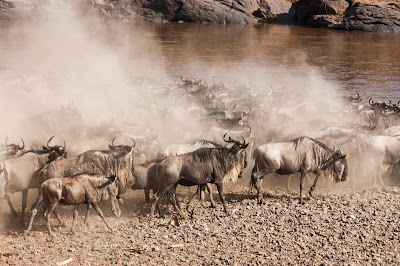After posting my update on the migration last week, things have changed in regard to wildebeests movement. The wildebeest have made another dramatic
come back. Over the last few days, the concentration in the south of the
reserve swelled to an enormous number. Most of the herds as per our previous
update have made a complete cycle in the past two weeks. They moved from the
eastern part of the river, crossed west onto the Mara Triangle, then south into
northern Serengeti and east from there before re-entering the Mara, crossing
the Sand river south of look out hill. Looking down into northern Serengeti,
just beyond the border, one can see thousands of animals on the plains heading
north into the Mara. There is now a high concentration of wildebeests south of
the Mara triangle. These are now crossing the Mara river east to Lookout hill.
I can only say of the present activities,
the migration has started again. There is a higher concentration around lookout
hill and east to the central plains. For the past three days, our guests have
witnessed many animals crossing below lookout hill. The animals are crossing east
onto the central plains. In the triangle the concentration is around Oldoinyo
Olkineji and south to the border of Serengeti.
While all these are going on in the south,
the northern section of the park seems to have slipped into a brief quite
period. The area around Musiara gate/marsh has only a handful of wildebeest
whereas earlier in the month, this area was all covered with wildebeests. On
the triangle as well, the northern section is still empty. We expect huge
crossings at paradise in the coming week when the animals will start crossing
the river east to paradise plains.
Map showing concentraion
wildebeests at cul de sac earlier
Wildebeests crosses the river at cul de sac














